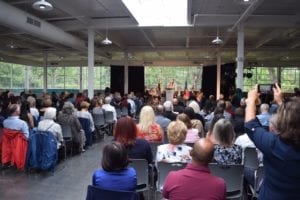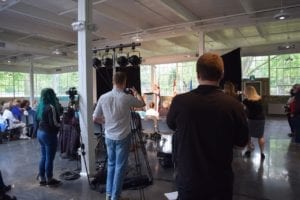Jonathan Shay speaks of moral injury in Achilles in Vietnam: Combat Trauma and the Undoing of Character (1994)
A previous post is entitled:
At the end of the above-noted post, I’ve mentioned other books that I’ve been reading, in addition to “We Were Soldiers Once …. and Young (1992),” that address the Vietnam War and related topics.

The photo is from the Snaptique Photo Booth, which was set up at the east windows of the room where the Small Arms Inspection Building Official Opening took place on June 23, 2018. At the booth, people could choose from a variety of historical artifacts. In my case, for this photo I chose a rotary-dial telephone, of a kind I recall from my childhood in Montreal in the 1950s.
The current post is devoted to one additional book, namely, Achilles in Vietnam: Combat Trauma and the Undoing of Character (1994)
The wounds of the drone warrior
I came across the book in an article, entitled “The Wounds of the Drone Warrior,” in the print edition of the June 17, 2018 Sunday New York Times Magazine.
The above-noted article is concerned with “moral injury,” a concept that dates from the Vietnam War.
The article notes that the term appears in “Achilles in Vietnam (1994),” and quotes (at p. 35 of the print edition of the article) the book’s author, the psychiatrist Jonathan Shay, as noting that “moral injury [that is, a betrayal of a sense of ‘what’s right’] is an essential part of combat trauma.”
The article adds that Jonathan Shay, in his 1994 study, also writes that “Veterans can usually recover from horror, fear and grief once they return to civilian life, so long as ‘what’s right’ has not also been violated.”
The New York Times article also quotes a researcher, Shira Maguen, who notes that “how veterans made sense of what they had done” during warfare – whether on the battlefield or while piloting a drone – is of central importance, with regard to moral injury, or moral wounds, experienced by some veterans, long after the killings have ceased.
“How you conceptualize what you did and what happened makes such a big difference,” Shira Maguen is quoted as saying in the article. “It makes all the difference.”
The article adds that, in the view of researchers like Maguen, moral injury goes beyond “intentionally doing something that you felt was against what you thought was right.” Instead, in the view of Maguen and others, “Moral injury is sustained by soldiers in the course of doing exactly what their commanders, and society, ask of them.”
The article notes that to the American military, such a definition of moral injury is “potentially more subversive” than a definition that is restricted to “something that you felt was against what you thought was right.”
Trust, safety, and social cohesiveness in the rear during mourning

Mississauga Mayor Bonnie Crombie at the podium, Small Arms Inspection Building Official Opening, June 23, 2018. The building in question, saved from demolition in 2008, served as an inspection facility for the nearby Small Arms Limited munitions plant during the Second World War. Jaan Pill photo
I have begun my study of “Achilles in Vietnam” by very closely reading two pages of the book, namely pp. 60-61 and imagining the events and situations described.
A subheading on p. 60 is entitled: “What was the level of trust, safety, and social cohesiveness during mourning?”
On p. 60, Jonathan Shay notes that, earlier in the text, he’s indicated that what he characterizes as griefwork requires some degree of security from enemy attack.
He adds that, in the case of the Vietnam War, “combat soldiers felt as unsafe in the rear as out in the field.”
The war in the field was against the Vietcong. Shay quotes a veteran as saying that the war in the rear, in turn, was a war “between blacks and whites.”
“Virtually all combat units were racially integrated and mostly color-blind in combat,” Shay notes, “but when they came to the rear, social cohesion fell to pieces.”
“Men also felt unsafe in the rear,” he adds, “because of the large number of Vietnamese civilians employed on American bases.” In part, this fear “reflected racist identification of all Vietnamese” as enemies, and in part it “reflected the reality that some of these civilians were gathering intelligence for the enemy, both on military operations in the field and for attacks on the rear-area bases themselves.”

View of east side of newly renovated south wing of Small Arms Inspection Building, June 23, 2018. Jaan Pill photo
Shay notes that the Vietcong were engaged in unconventional warfare – which among other things, created dangers for soldiers even in the rear-area bases in Vietnam.
In previous posts, I have explored the role that unconventional, or irregular, warfare played in the Second World War. This form of warfare, also known as hybrid warfare, has continued to evolve.
Rotational policy
On p. 61, Shay observes that in Vietnam, a policy of individual (as contrasted to unit) rotation policy “systematically destroyed the unit cohesion of combat groups. Very, very few Vietnam veterans went over with the unit they had trained with, fought with that unit, and [emphasis in original] returned ‘to the world’ with it.”
Having read pp. 60-61, I decided to read the rest of Chapter 3, “Grief at the Death of a Special Comrade.”
Grief and the warrior’s rage
A section of Chapter 3, beginning on p. 53, bears the subheading, “Grief and the Warrior’s Rage.”
A passage from pp. 53-54 reads:
“What I want to emphasize here is the rapid transformation of grief into rage. For many of the veterans in our treatment program for combat post-traumatic stress disorder, replacement of grief by rage has lasted for years and become an entrenched way of being. Much therapeutic effort aims at reawakening the experience of grief, which we regard as a process of healing, painful as it is. This reflects our beliefs, [emphasis in original] not conclusive scientific fact. We simply do not know which aspects of emotion are biological universals, like the heartbeat, and which aspects of emotion are culturally constructed.”
Shay notes (p. 58) that “Time and safety to mourn were built into ancient warfare and were absent in Vietnam.”
On p. 59, he notes that “In Vietnam, when the corpse disappeared from the battlefield the thread of griefwork snapped at its origin.”
That is to say, the comrades of the fallen were seldom involved in activities by the bereaved for the dead, nor was there significant involvement of the bereaved with each other. When these activities and involvements are absent, predictable consequences ensure.
On p. 62 we learn that “Mind-altering substances of all sorts seem to have been the main shrines to which American soldiers brought their grief.”
The chapter concludes with the observation that “Thwarted, uncommunalized grief is a major reason why there are so many severe, long-term psychological injuries from the Vietnam War.”
Communalization of grief
Chapter 3 explores grief, rage, the “communalization of grief,” and the antecedents of “berserk” behaviour among returning Viet Nam veterans.
The exploration offers the reader the opportunity to better comprehend the dynamics of post-traumatic stress disorder.
This is an excellent book, available from the Toronto Public Library; I recommend it highly, for any person with an interest in world military history and related topics.
Odysseus in America (2002)
A subsequent book by the same author is entitled: Odysseus in America: Combat Trauma and the Trials of Homecoming (2002)
In the latter study, Jonathan Shay among other things highlights the origins of the rotational policy of the American military, which served to diminish the unit cohesiveness of combat groups.
In effect, a management model, entrenched in the business world at the time, was applied to management of combat groups. Under such a system, as I understand from a quick reading of a passage in the book, individual soldiers were treated as interchangeable parts rather than as key elements of a cohesive combat unit.
Updates
A May 13, 2019 Yale Environment 360 article is entitled: “Fifty Years After, A Daunting Cleanup of Vietnam’s Toxic Legacy: From 1962 to 1971, the American military sprayed vast areas of Vietnam with Agent Orange, leaving dioxin contamination that has severely affected the health of three generations of Vietnamese. Now, the U.S. and Vietnamese governments have joined together in a massive cleanup project.”
An Aug. 9, 2019 CNN article is entitled: “Southwest pilot flew his Vietnam veteran father’s remains back to the place where he last saw him 52 years ago.”



Leave a Reply
Want to join the discussion?Feel free to contribute!